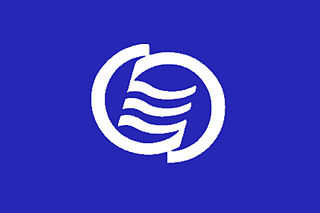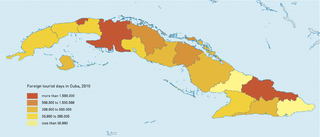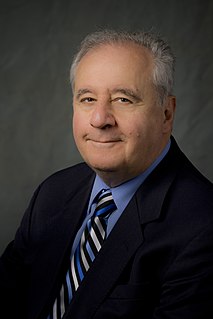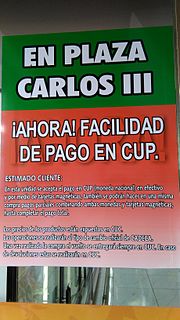
The economy of Cuba is a mixed command economy dominated by state-run enterprises. Most of the labor force is employed by the state. In the 1990s, the ruling Communist Party of Cuba encouraged the formation of worker co-operatives and self-employment. In the late 2010s, private property and free-market rights along with foreign direct investment were granted by the 2018 Cuban constitution. Foreign direct investment in various Cuban economic sectors increased before 2018. As of 2000, public-sector employment was 76% and private-sector employment was 23%, compared to the 1981 ratio of 91% to 8%. Investment is restricted and requires approval by the government. In 2019, Cuba ranked 70th out of 189 countries on the Human Development Index, placed in the high human development category. As of 2012, the country's public debt comprised 35.3% of GDP, inflation (CDP) was 5.5%, and GDP growth was 3%. Housing and transportation costs are low. Cubans receive government-subsidized education, healthcare, and food subsidies.

In Cuba, women have equal constitutional rights as men in the economic, political, cultural and social fields, as well as in the family. According to Article 44 of the Cuban Constitution, "The state guarantees women the same opportunities and possibilities as men in order to achieve woman’s full participation in the development of the country." As of 2015, women hold 48.9% of the parliamentary seats in the Cuban National Assembly ranking sixth of 162 countries on issues of female participation in political life. Many women in Cuba come from different racial backgrounds including Afro-Cuban women. Along with Afro-Cuban women, women in Cuba, formerly a marginalized group, were able to gain higher educational levels and equal advancements in their respective careers. The 1975 Family Code was designed to allow Cuban women to share the household duties fairly with their spouses. Job opportunities were available in the cities and as a result, many Cuban women left the countryside to work and live in the cities. However, because of the increased number of Cuban women studying and working, the national birth rate has declined. Despite the fact that desegregation was enforced in Cuba, there are still some issues in regards to fair housing in Cuba.

The American Society of Civil Engineers (ASCE) is a tax-exempt professional body founded in 1852 to represent members of the civil engineering profession worldwide. Headquartered in Reston, Virginia, it is the oldest national engineering society in the United States. Its constitution was based on the older Boston Society of Civil Engineers from 1848.

The Association of Caribbean States is an advisory association of nations centered on the Caribbean Basin. It was formed with the aim of promoting consultation, cooperation, and concerted action among all the countries of the Caribbean coastal area. The primary purpose of the ACS is to promote greater trade between the nations, enhance transportation, develop sustainable tourism, and facilitate greater and more effective responses to local natural disasters.
A CPA, or Agricultural Production Cooperative, is a type of agricultural cooperative that exists in Cuba today.

Tourism in Cuba is an industry that generates over 4.7 million arrivals as of 2018, and is one of the main sources of revenue for the island. With its favorable climate, beaches, colonial architecture and distinct cultural history, Cuba has long been an attractive destination for tourists. "Cuba treasures 253 protected areas, 257 national monuments, 7 UNESCO World Heritage Sites, 7 Natural Biosphere Reserves and 13 Fauna Refuge among other non-tourist zones."

Cuba, officially the Republic of Cuba, is an island country comprising the island of Cuba, as well as Isla de la Juventud and several minor archipelagos. Cuba is located where the northern Caribbean Sea, Gulf of Mexico, and Atlantic Ocean meet. Cuba is located east of the Yucatán Peninsula (Mexico), south of both the American state of Florida and the Bahamas, west of Hispaniola, and north of both Jamaica and the Cayman Islands. Havana is the largest city and capital; other major cities include Santiago de Cuba and Camagüey. The official area of the main island of Cuba is 109,884 km2 (42,426 sq mi) but a total of 350,730 km² including the exclusive economic zone. The main island of Cuba is the largest island in Cuba and in the Caribbean, with an area of 109,884 km2 (42,426 sq mi). Cuba is the second-most populous country in the Caribbean after Haiti, with over 11 million inhabitants.

After the establishment of diplomatic ties with the Soviet Union after the Cuban Revolution of 1959, Cuba became increasingly dependent on Soviet markets and military aid and was an ally of the Soviet Union during the Cold War. In 1972 Cuba joined the COMECON, an economic organization of states designed to create co-operation among the communist planned economies, which was dominated by its largest economy, the Soviet Union. Moscow kept in regular contact with Havana and shared varying close relations until the end of the Soviet Union in 1991. Cuba then entered an era of serious economic hardship, the Special Period.
The Allied Social Science Associations (ASSA) is a group of academic and professional organizations that are officially recognized by the American Economic Association (AEA) and are related to the study of social sciences. As of 2007, there are fifty organizations that participate in the annual meetings of the ASSA, including:

Gobichettipalayam Vasudevan "G. V." Loganathan was an Indian-born American professor, who, at the time of his death, was a professor in the Department of Civil and Environmental engineering, part of the College of Engineering at Virginia Tech, United States.
Water supply and sanitation in Cuba is characterized by a high level of access. A state-owned enterprise is in charge of providing services throughout the country within the country's socialist, centrally planned Cuban economic system. As a surprising exception in a Socialist country, a mixed public-private company with partial foreign ownership provides services in parts of Havana.
Prostitution in Cuba is not officially illegal; however, there is legislation against pimps, sexual exploitation of minors, and pornography. Sex tourism has existed in the country, both before and after the 1959 Cuban Revolution. Many Cubans do not consider the practice immoral. In Cuban slang, female prostitutes are called Jineteras, and gay male prostitutes are called Jineteros or Pingueros. The terms literally mean "jockey" or "rider", and colloquially "sexual jockey", and connotes sexual control during intercourse. The terms also have the broader meaning of "hustler", and are related to jineterismo, a range of illegal or semi-legal economic activities related to tourism in Cuba. Stereotypically a jinetera is represented as a working-class Afro-Cuban woman. Black and mixed-race prostitutes are generally preferred by foreign tourists seeking to buy sex on the island. UNAIDS estimate there are 89,000 prostitutes in the country.
Vegard Bye is a Norwegian political scientist, writer, consultant and ex-politician. He has represented the UN High Commissioner for Human Rights in Angola and Bolivia, written extensively on Latin America, and is a consultant specializing on human rights, democracy, conflict and post-conflict societies as well as solar energy. He served as a Substitute Representative (Vararepresentant) to the Norwegian Parliament for the Socialist Left Party from Oslo (1993-1997), meeting in the Standing Committee on Foreign Affairs.

Cuba has suffered from widespread and rampant corruption since the establishment of the Republic of Cuba in 1902. The book Corruption in Cuba states that public ownership resulted in "a lack of identifiable ownership and widespread misuse and theft of state resources... when given opportunity, few citizens hesitate to steal from the government." Furthermore, the complex relationship between governmental and economic institutions makes them especially "prone to corruption."

Dan Mircea Frangopol is an American civil engineer and the inaugural holder of the Fazlur R. Khan Endowed Chair of Structural Engineering and Architecture at Lehigh University, Bethlehem, Pennsylvania.

The dollarization of Cuba refer to macroeconomic policies implemented with the aim at stabilising the Cuban economy after 1993. They were initially enacted to offset the economic imbalances which was a result of the dissolution of the Soviet Union in 1991. The main aspect of these reforms was to legalize the then illegal U.S. Dollar and regulate it's usage in the island's economy.
Kumares C. Sinha is an Indian-American engineer, researcher and educator known for contributions to transportation systems analysis, transportation infrastructure economics and management, transportation safety, and the use of emerging technologies in transportation. He has served as Edgar B. and Hedwig M. Olson Distinguished Professor of Civil Engineering at Purdue University. since 1998.
Lillian Guerra is a Professor of Cuban and Caribbean history and the Director of the Cuba Program at the University of Florida. A widely published author and researcher, she is considered one of the leading Cuban history experts in the world.
A Cuban exile is a person who emigrated from Cuba in the Cuban exodus. Exiles have various differing experiences as emigrants depending on when they migrated during the exodus.

The dual economy of Cuba was developed after the dissolution of the Soviet Union, which caused major economic changes on the island. Tourism was regarded as the only stable sector of the Cuban economy and became the subject of policy changes to enhance its development. Cuba legalized the use of the US Dollar and created a dual currency system, one based on the dollar and the Cuban convertible peso with the other system based on the Cuban peso. Different institutions and businesses operated only one side of the currency divide. The Cuban peso, used mostly by Cuban nationals, cannot buy imported goods. The goal of the dual economy was to create one economic sphere designed to utilize foreign investment, while keeping it separate from the other economic sphere of domestic activities.










